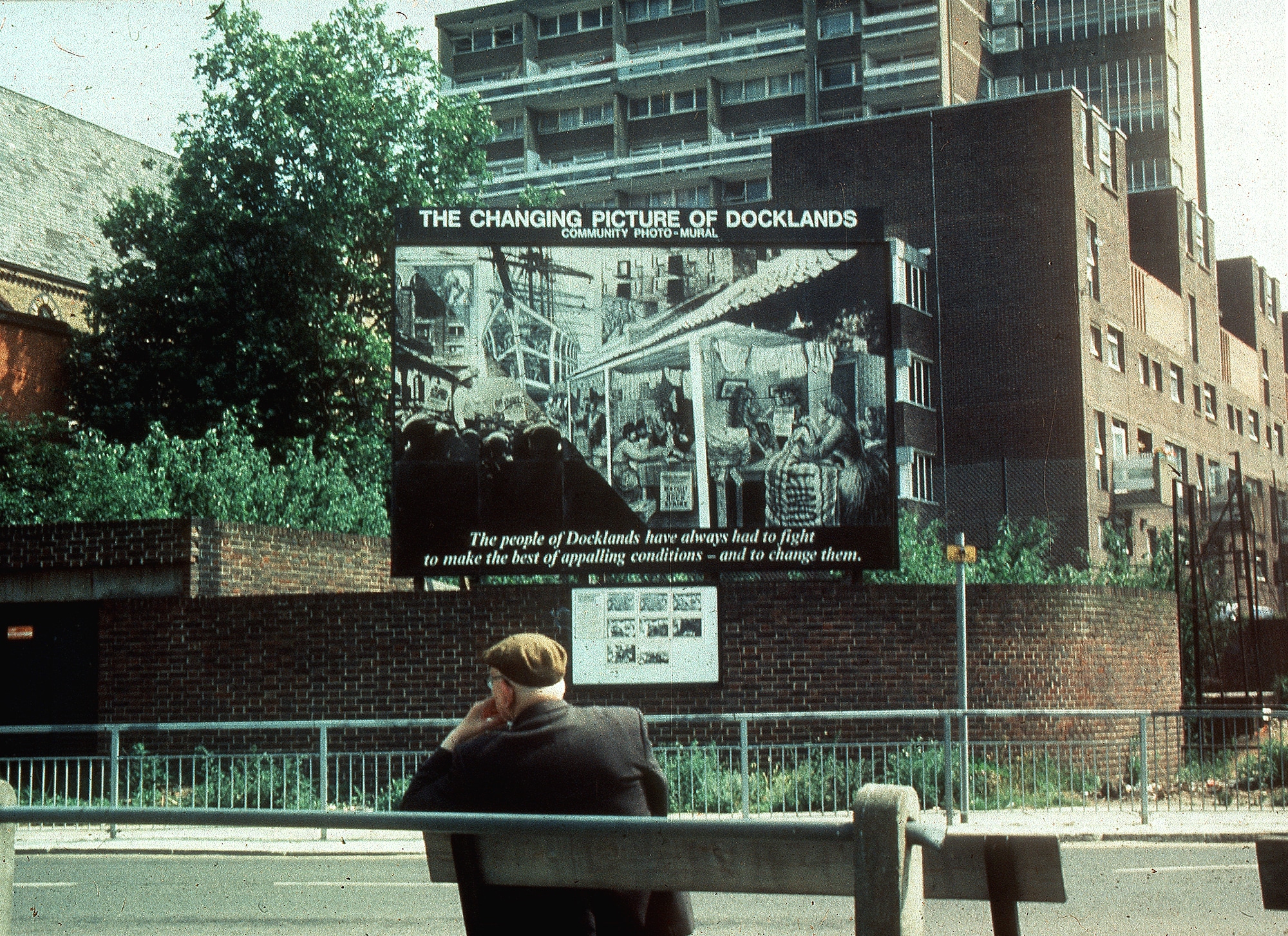Created by Peter Dunn & Loraine Leeson
Loraine was born in 1951 an only child of dedicated, aspirational and creative parents. Her father, initially from an impoverished background, rose to officer after conscription to the Army in WW2, following which he was able to take achieved a white collar job on an American air-base. He wrote short stories. Her mother was a secretary who became a dressmaker and taught in a London fashion school. The family lived in a flat in Kenton in Middlesex, in a place where all the children used to play outside and where she would escape from adult chatter to her godmother’s house two doors down, where she was saturated with reading. All that changed when the family moved to Ruislip – and isolation – “the living death – I yearned for community.”
She did well at primary school and went to a prim and proper girl’s grammar where she enjoyed teenage life with her friends, was academically successful, and rebellious. She was smitten with English as well as Art, though applied to St Martins School of Art when her first application to study art at Reading University was unsuccessful.
Saint Martins pre-diploma course
“Moving from the suburbs to Soho was a real education, – the best year of my life – I met such interesting people from different walks of life.” The foundation course was “as they really ought to be, doing mind-blowing projects, a different creative problem every day!”
the misfits group
From there Loraine went on to Reading to a course combining Art History with Art. She enjoyed her first year, which included creative writing, as well as art history, but “the art was a downer.” She did not fit into the more traditional art forms offered by the atelier system, so joined a ‘misfits group’, where students from different years explored experimental film-making with Ron Haseldon – “and I never did another painting after that,” she says.
Peter was born in 1946, his family part of a working-class Irish community in Liverpool. His father was a socialist, a shop steward, a boxing champion and coach. From him Peter says he inherited his love of philosophy and music. His mother, tory, middle-class and aspirational, was adventurous, took Peter and his sisters off for camping holidays in Cornwall and encouraged his painting and drawing. He recalls playing in the fields near home, and in the bomb-sites, the sand-barges and ferries – “I was fascinated by the river and the docks – my grandfather was a docker and we would sometimes meet him coming from work.” He was always drawing – recalling his where he had been, what he had done.
family parties
Among the back to back houses where his grand-parents lived, with ginnels and yards and a square in the centre with a bandstand where all the children would play. There were regular get-togethers of both his parents families for parties, and his aunts and uncles would take turns perfoming, singing songs and dancing.
His Catholic primary & secondary schools were dreadful and brutal, with fifty pupils to a class. The secondary school was a Secondary Modern that added a so-called ‘Grammar Stream’, on route to becoming a Comprehensive – his was the first cohort to do GCE, but no one passed). However, because his class room was in the library (due to over crowding) he began to read voraciously. He discovered Darwin’s ‘Origin of the Species’ and began to ask awkward questions which got him into trouble – he was caned frequently – the school was featured in the campaign to abolish corporal punishment.
They didn’t have an art teacher in the school but he drew all the time, both from his environment and from books, wherever he found inspiration. When he left school he got an engineering apprenticeship at Fords, but he hated it, especially the sadistic discipline. Peter had been playing in local bands from the age of fifteen and, when his band was offered gigs in Germany, he left Fords, and went on a tour of Europe. “It was a taste of the world!” He also started to paint during that time and found he had a real ability using oils, creating images from imagination that were admired for being ‘surrealist’ (although he didn’t know what that was then). His last band, The Riot Squad, had David Bowie as lead singer, Mitch Michel as drummer, and he stood in for Noel Reading, playing with Jimmy Hendricks in Frankfurt.
art history at Croydon
So when around 1968 the band fell on hard times and broke up, he briefly went back to piecework in a Factory. He went to evening classes at Croydon College where he became “totally fascinated by art history, especially its social context, and discovered he could get a grant to study art ”. He passed the required ‘A’ levels, and was accepted for the course at Reading University, where he began to question, “Who am I making art for?” and thus began the quest which was to map out his future work.
who am I making art for?
At Reading Caroline Tisdall was one of their art history tutors. “Interested in this whole thing about art and society, and we learned all about Joseph Beuys.” As well as lectures at the university, Caroline Tisdall held meetings and discussions with artists, curators, writers and students at her house. “Talking about art and society, it was our own ferment of ideas.” Peter was employed as a researcher for Beuys’ Free University and he and Loraine took part in Documenta 6 in Kassel engaging in discussions with Beuys along side his Honeypump installation.
Beuys’ concept of ‘Interdisciplinarity’ was seminal – “if you want to change the world you need to partner up with people who know other things.”
After they left Reading University in 1975 Peter went on to do his masters at the Slade School of Art, whilst Loraine won a year’s scholarship to the Hochschule der Künste in Berlin. “Peter and Loraine started to work together, “with telephone links, performances, videos and discussions, and showed the results in events we staged at each institution.” Loraine became an ‘associate student’ of the Slade and together they developed ideas for practical applications of art in society.
During this time they liaised with artist Stuart Brisley, who was on an APG placement in the new town Peterlee, and developed a project The Present Day Creates History that compared the politics and social effects of this new development with that of the suburb Ruislip, where Loraine had grown up. This work threw up both challenges and lessons. Then in 1977, while on a Greater London Arts film/video fellowship, they assisted the campaign to save the Bethnal Green Hospital. Joining in, collaborating, creating montages, producing posters and going on marches, “This felt like it was really working! Working with people and not trying to do it all as artists. And that was a watershed. That moment!” At the beginning they lived on unemployment benefit in spartan short-life East-End housing. Only later were they able to get part-time teaching work. There were many friends and allies. They became involved or networked with the radical photography centre Camerawork, Four Corners film collective, the Basement Project and many other community arts and political arts groups – “networks which made our work easier”. Loraine noted that, on reflection, “gender equality was something we all aspired to but never quite achieved.”
Bethnal Green Hospital Campaign – conclusions
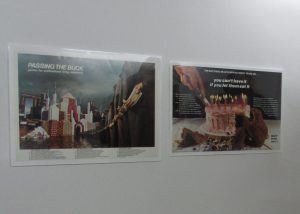 From 1978 – 80, following the Bethnal Green Hospital project, Peter and Loraine worked with a steering group of trades councils, health unions and members of the Tower Hamlets Health Campaign as the East London Health Project. Through this they designed and produced a series of posters about the potential effects of the cuts in the NHS, which were distributed through the unions for display in health centres and doctors’ surgeries and waiting rooms. It was a useful preparation for their next move.
From 1978 – 80, following the Bethnal Green Hospital project, Peter and Loraine worked with a steering group of trades councils, health unions and members of the Tower Hamlets Health Campaign as the East London Health Project. Through this they designed and produced a series of posters about the potential effects of the cuts in the NHS, which were distributed through the unions for display in health centres and doctors’ surgeries and waiting rooms. It was a useful preparation for their next move.
The Docklands Community Poster Project.
In 1981 the development of London’s Docklands became the major political and social issue for people living in the riverside areas of east and southeast London. Since the 1960s cargo had been shifting down river to container ports, leaving the up river docks redundant. The Labour government of the time had given powers to the five docklands boroughs to make development plans for the future of docklands, jobs and housing. However the incoming Conservative government created the London Docklands Development Corporation (LDDC), an unelected QUANGO, answerable only to the central government, whose brief was to privatise all development in the area – home and workplace to many thousands of people. Historically East London communities had been poor but politically active. In this case they were not against development, but wanted it to also meet their own needs. They had a reputation for organised resistance. A struggle ensued. The local trades council approached Peter and Loraine to assist local people in their campaign – this resulted in the creation of the Docklands Community Poster Project (DCPP) in 1981.
“They asked us to work with tenants and action groups to produce a poster alerting local people as to what was to come. Tenants in the area were already federated into local action groups and when we consulted them, thought posters were indeed wanted, but large ones to match the scale of the proposals.” These groups had also formed the Joint Docklands Action Group, through which they hired professional planners and organisers to co-ordinate the campaigning. The DCPP organised on similar lines, becoming a community co-op, and with funding from the Greater London Council and local boroughs, took on other skilled people to assist with administration, design and technical support. Representatives of local groups met regularly at the DCPP to report on the progress of the campaign, discuss themes and issues to be represented, as well as to consider the audience and actions needed.
Miles of corrugated iron were now surrounding what was left of the docks. Local people were left stranded in poor housing with few facilities, and unaware about what was going on. So the main audience for the proposed ‘large-scale’ posters, soon to be called ‘photo-murals’, would be the Docklands communities themselves. The images would be mounted on billboards eighteen feet long by twelve high. The siting of these images was also important since, unlike commercial advertising billboards, they were positioned where they could be viewed by pedestrians rather than passing cars. The first was installed opposite a health centre in Wapping, then over subsequent years there were seven more around the Docklands area, six operating at any one time. The photo-murals each comprised eighteen 3 x 4 foot sections, mounted onto plywood panels. In this way the murals were able to change gradually through replacement of individual sections, and develop a narrative like a slow motion animation. In practical terms this meant the images could be transferred from one site to another, enabling the story of the Docklands to unfold through time and space – “The Changing Picture of Docklands”. It is the intense drive of the message coming together with its surreal language of montage that makes the art so expressive.
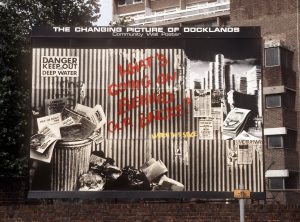 The first artwork to be displayed was ‘What’s going on behind our backs?’, referring to the question on everyone’s lips as to what was being hidden behind the miles of corrugated iron. “Big money is moving in and is pushing out local people,” said one activist at a public meeting, so inspiring the next image of the sequence. A few panels were progressively removed to show growing towers of money pushing people into an abyss. In meetings, fear of being thrown onto the ‘scrap heap’ was frequently expressed, so the next image revealed a drawing of the scrap heap, followed by the hand of the LDDC drawing it – it was the developers’ design for Docklands, not where the communities saw themselves. The final image in that sequence is a portrait of the community in front of the landscape of Docklands where the drama was being enacted. It reflected the strength developing in the campaigning communities in their fight for their rights against the LDDC and included these words from the chair of the Association of Wapping Organisations:
The first artwork to be displayed was ‘What’s going on behind our backs?’, referring to the question on everyone’s lips as to what was being hidden behind the miles of corrugated iron. “Big money is moving in and is pushing out local people,” said one activist at a public meeting, so inspiring the next image of the sequence. A few panels were progressively removed to show growing towers of money pushing people into an abyss. In meetings, fear of being thrown onto the ‘scrap heap’ was frequently expressed, so the next image revealed a drawing of the scrap heap, followed by the hand of the LDDC drawing it – it was the developers’ design for Docklands, not where the communities saw themselves. The final image in that sequence is a portrait of the community in front of the landscape of Docklands where the drama was being enacted. It reflected the strength developing in the campaigning communities in their fight for their rights against the LDDC and included these words from the chair of the Association of Wapping Organisations:
“There has been a lot of talk about land, land for this, land for that. But Docklands is not about land, it’s about people. And the birthright of the people is being sold off. Although the people have never owned the land, they’ve lived on it, worked on it, died on it. It is their heritage – it should be their future.”
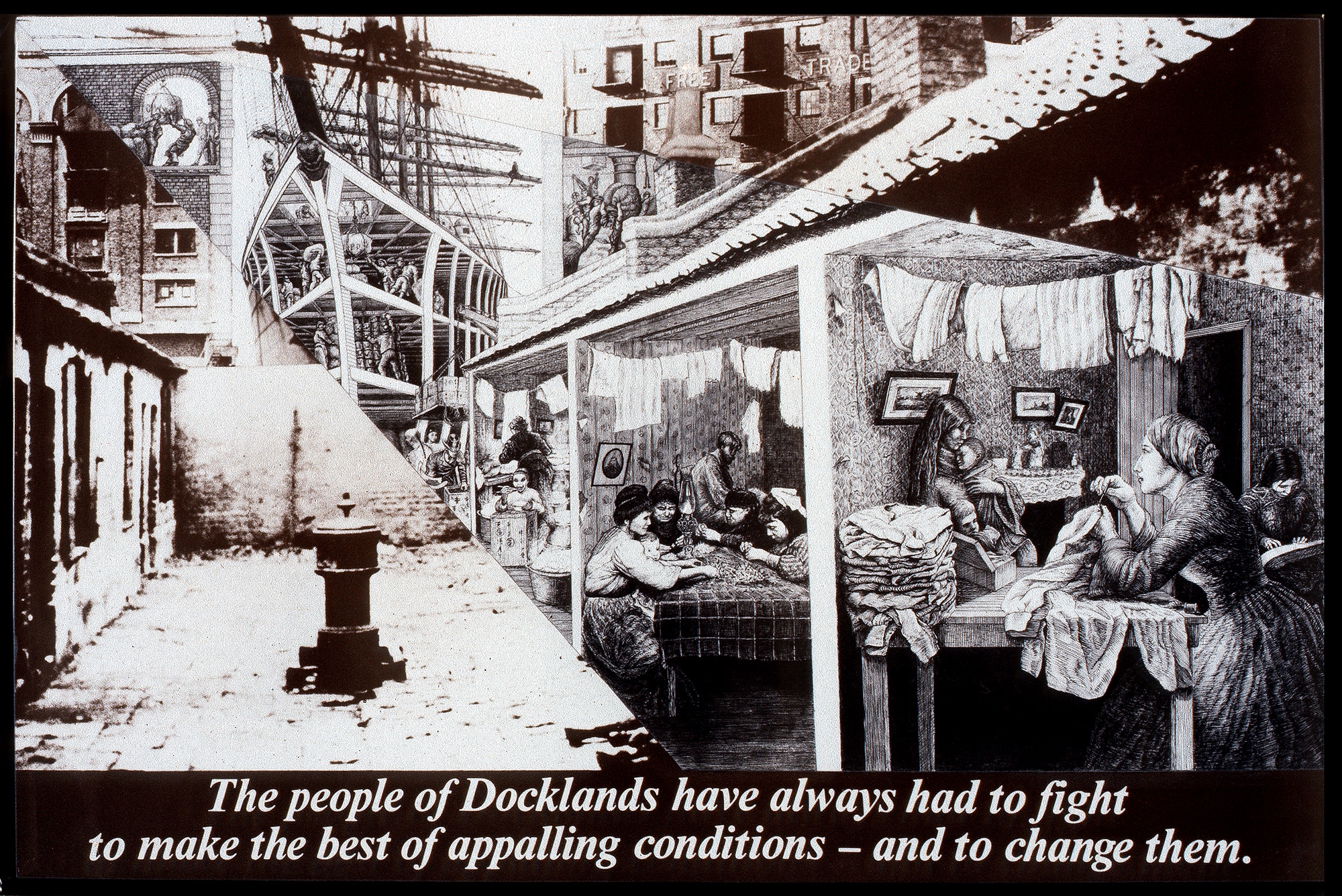 The second sequence of photo-murals focused on housing and living conditions. The community were fighting campaigns to have social housing included in what were now totally commercial developments. It was felt that putting current campaigns in a historical context was important, to provide a sense of continuity and that victories had been won in the past. The opening caption proclaimed: “The people of Docklands have always had to fight to make the best of appalling conditions – and to change them.” It showed a ship towering over a street at the turn of the century, an example of typical reformist photography of the period showing people as victims of poverty. This was then opened up – using the drawing style featured in the London Illustrated News that Peter had perfected to depict people active inside, particularly women, and the Chinese community.
The second sequence of photo-murals focused on housing and living conditions. The community were fighting campaigns to have social housing included in what were now totally commercial developments. It was felt that putting current campaigns in a historical context was important, to provide a sense of continuity and that victories had been won in the past. The opening caption proclaimed: “The people of Docklands have always had to fight to make the best of appalling conditions – and to change them.” It showed a ship towering over a street at the turn of the century, an example of typical reformist photography of the period showing people as victims of poverty. This was then opened up – using the drawing style featured in the London Illustrated News that Peter had perfected to depict people active inside, particularly women, and the Chinese community.
making the images
The joining forces of the Dockers union and East London Suffragettes featured. As these images moved into the present day, via post war developments, two new campaigns took on an urgency – the Canary Wharf and Royal Docks Developments. It was decided to link these back to the original “Big Money” image – creating a Big Money trilogy – to emphasise the fact that the scale of the development had increased exponentially and the march eastward and the creation of City Airport needed to be addressed.
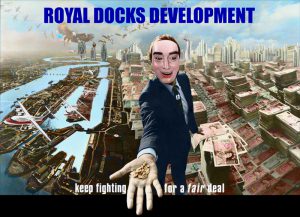
“The photo-murals were only one aspect of our activities. We were producing artwork for leaflets publications, posters and banners, documenting each area before it changed, recording each battle, and telling everyone what was being proposed. We also started to build a negative archive of key events and developments as an image resource for other projects, and produced exhibitions about the project, laminated and portable, to be used in a tenants’ halls or festival tents or larger venues.”
the bad guys and the docklands road show
“The LDDC was set up by the government to take land away from local authorities, and became a model for similar schemes. Using our experience it seemed a good idea to send ‘A warning from London Docklands’ to communities, activists, theorists, artists, planners to prepare their strategies for confronting the challenge. We started pulling it all together as the Docklands Roadshow, which commenced with a big rally at Newham Town Hall. When it was complete it was offered around the country, and went also to Amsterdam and Berlin.”
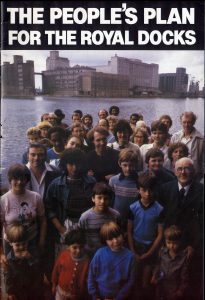 As campaigning progressed, people were discovering that proposing alternative strategies was more effective than being oppositional. “One example was the Peoples’ Plan for the Royal Docks, (1983) where people developed their own plan for what should go there rather than the proposed London City Airport. It was far better researched and is still in use today as a model of community planning. It’s better to be doing your own thing and recognise your own power than just be oppositional, because that can also confer power onto those who already have it.”
As campaigning progressed, people were discovering that proposing alternative strategies was more effective than being oppositional. “One example was the Peoples’ Plan for the Royal Docks, (1983) where people developed their own plan for what should go there rather than the proposed London City Airport. It was far better researched and is still in use today as a model of community planning. It’s better to be doing your own thing and recognise your own power than just be oppositional, because that can also confer power onto those who already have it.”
“Most important was the way the campaign meshed with the campaign groups. The best example was the ‘People’s Armada to Parliament’ (1984) which grew out of meetings held by the Joint Docklands Action Group. What began as an idea for a modest river event became an Armada involving fleets of decorated boats, thousands of people on and along the river, as well as festivals and fireworks. It altered the whole scale and tone of Dockland’s campaigning. Once cultural activity joins political action, it helps make it effective but also fun. There can be no turning back!”
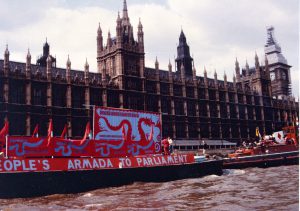
The Docklands Community Poster Project continued to 1991, it’s work inspiring communities everywhere, teaching the skills of resistance and contributing to new thinking about people, place, the role of the artist, potential of the new vocabularies of artistic expression and the delight of interdisciplinary collaboration.
“The scale of engagement – federating tenants and action groups across five boroughs – and its the methodology – not just asking people what they want, but involving them (and us) in a process that went deeper and brought together a wider range of expertise – became seminal for the theory and practice of social engagement. Someone living in a run-down estate is an expert in what it¹s like to live there, may understand the process of campaigning and how to create networks to make it happen.”
Using what they had learned, shifting from reactive campaigning to proactive intervention, they created The Art of Change in 1991. In 2001, Peter created ART.e (Art, Regeneration, Technologies, environment) and Loraine created cSPACE; both continuing to work with communities and constituencies.
Loraine and Peter are now lecturing, writing and working on individual new projects.
http://www.arte-ofchange.com/content/docklands-community-poster-project-1981-8
http://cspace.org.uk/category/archive/docklands-community-poster-project/
